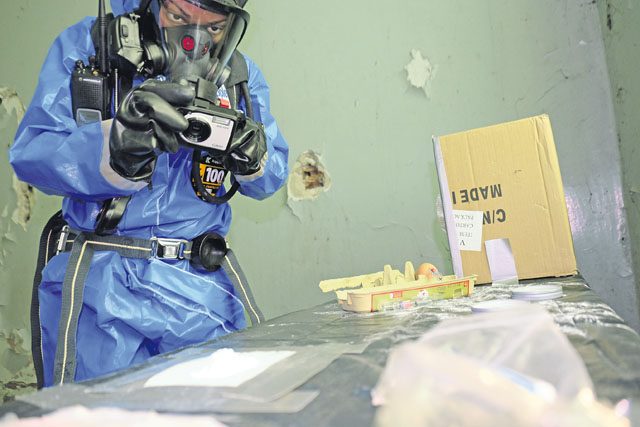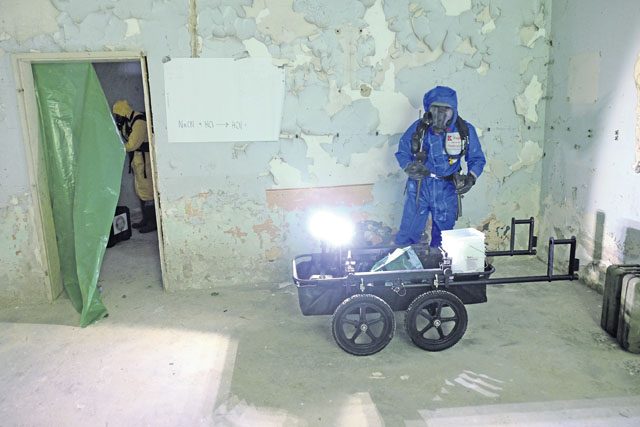
PODGORICA, Montenegro —This tiny Balkan nation of about 620,000 people hosted the annual NATO European-Atlantic Disaster Coordination Center Consequence Management field exercise.
CRNA GORA 2016 included 33 Army Reserve Soldiers and one civilian from the 7th Mission Support Command, with 680 participants from 32 countries, during the training event Oct. 31 through Nov. 3.
The 7th MSC and its Medical Support Unit-Europe, the 773rd Civil Support Team, 361st Civil Affairs Brigade, 209th and 2500th Digital Liaison Detachments conducted foreign consequence management operations in response to a simulated flooding event at sites in and around the capital city of Podgorica.
“(The exercise) is designed to bring together many, many nations to practice civil emergency type activities,” said Dr. John Manza, NATO’s deputy assistant secretary general for operations.
According to Manza, the eight disaster response sites were chosen to test the various teams on search and rescue, CBRN response and water rescue.
“It’s an opportunity for different countries to come together and participate in a Consequence Management Field Exercise,” said Col. Tyra Harding, 7th MSC officer in charge.
On the first day, the teams conducted classroom and familiarization training.
“The Medical Support Unit-Europe is here coordinating with other countries and seeing how we can integrate and supplement and work together to provide medical support in the case of a natural disaster,” said Capt. Allison Boss, MSU-E.
The second day of CRNA GORA 2016 started when multiple disaster sites called for assistance in response to the flooding scenario injects from the EADRCC exercise staff.
The Rogami bridge site, next to the river Zeta, simulated an ambulance crash with the vehicle on its side along the steep river bank.
The Montenegro Onsite Commander Darko Zizzic, a Montenegro rescue 3 level commander, called for medical responders, search and rescue teams, a boat rescue team with divers and a Chemical Biological Radiological Nuclear identification unit.
The 7th MSC sent three MSU-E Soldiers to assist the search and rescue team from Azerbaijan and the Israeli water rescue team.
Around the same time, the 773rd CST was requested by a different Montenegro onsite commander to go to the former schoolhouse in Lazine to check on a suspected chemical factory or ‘meth lab’ with the Armenian CBRN team.
“The communication between us and them was good,” said Staff Sgt. Yulolanda Carey, survey team chief, 773rd CST. “You get to incorporate some of what they know with what we know.”
The combined Armenian and U.S. teams conducted perimeter monitoring and site characterization at the dilapidated schoolhouse.
“It was interesting to see their (Armenian CBRN team) process as compared to ours,” said Staff Sgt. Patrick McNeely, 773rd survey team member.
Meanwhile, back at the Rogami Bridge, the 7th MSC medics were part of a team of the Israel, Azerbaijan and U.S. personnel.
“When the mission was clear, we divided the team,” said Yosef Dekalo, commander of the Israeli fire department search and rescue team.
As the sun was setting and the temperature dropped, the teams learned the nearby bridge was unusable for the training scenario due to the simulated floods. So, the 7th MSC medics crossed the Zeta river onboard an Israeli water rescue team Zodiac boat.
Once on the opposite side, the U.S. MSU-E partnered with the Azerbaijan SAR members to traverse a very steep river embankment and triage patients in the dark.
“I enjoyed working with them as a team,” said Abbasov Ibrahim, an Azerbaijan Army search and rescue worker. “I learned some things from them.”
The next day, the 773rd CST, the Armenian CBRN unit and the Spanish Emergency Military Unit were called out to conduct a CBRN site survey at the Lazine site.
The 773rd CST partnered with the Armenian CBRN team for the site survey and the Spanish UME conducted decontamination.
“It was very nice to work with the U.S. Army team,” said Senior 1st Lt. Tigran Gevorgyan, Ministry of Emergency Situation of Republic of Armenia, CBRN Division.
The final day was held at the Plavnica Eco-Resort south of Podgorica. Events included static displays, a demonstration of CBRN capabilities and a press conference.
“I think it is so important to show that NATO is not just about cooperative defense; it is also involved in dealing with natural disasters, helping countries to address terrible situations that arise,” said NATO Deputy Secretary General Rose Gottemoeller during her post ceremony press conference. “I thank Montenegro for the terrific work that your people did, your teams did, to organize this important exercise.”
Montenegro is currently in the NATO accession process and is expected to become an official member in the spring of 2017, Gottemoeller said.



